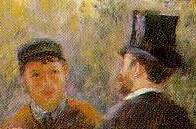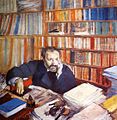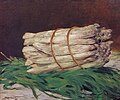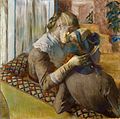Charles Ephrussi

Charles Ephrussi (also Charles Éphrussi or Karl Ephrussi , born December 24, 1849 in Odessa , † September 30, 1905 in Paris ) was a banker , art historian and editor of the respected art magazine Gazette des Beaux-Arts . His publications include works on Albrecht Dürer and Paul Baudry . As an art collector, he was one of the earliest patrons of French Impressionist painters .
family
The Ephrussi family had settled as a Greek Sephardic in Odessa, Russia at that time, and were active in European trading and banking in the 19th century. Charles Joachim Ephrussi (1792–1864), the grandfather of Charles Ephrussi, laid the foundation for the family fortune with a successful grain trade. His eldest son Leonid (also Léon , around 1820–1877) founded the banking house Leonid Ephrussi & Co in Odessa , which existed until 1882. From his marriage to Minna Landau (1824-1888) Charles Ephrussi emerged as the third of four children. The family moved to Paris in 1871, where the father's brothers, Michel (1845–1914) and Maurice Ephrussi (1849–1916), together with Jules Ephrussi (1846–1915), the eldest brother of Charles Ephrussi, ran the Ephrussi & Co . justified. This bank was the Paris branch of the banking house Ephrussi & Co. founded in Vienna in 1856 by Ignaz von Ephrussi , another brother of his father. Another bank branch existed in London. The French branch of the family maintained close entrepreneurial and friendly relationships with other wealthy banking families such as the Reinachs and Rothschilds . The daughter of Charles Ephrussi's sister Betty (1852–1873), Fanny Thérèse Kann, married the ancient historian Théodore Reinach and the uncle Maurice Ephrussi married the millionaire heiress Béatrice de Rothschild . The legal scholar Carl Bernstein was a cousin and the playwright Henri Bernstein was the son of a cousin of Charles Ephrussi.
Life
Charles Ephrussi, born in Odessa, studied first in his hometown and then in Vienna before settling in Paris. Here he initially worked in the family's banking house. In 1875 he began working for the respected art magazine Gazette des Beaux-Arts . At first he devoted himself to the Renaissance and published a work on Jacopo de 'Barbari in 1876 . He then wrote several works on Albrecht Dürer . In addition, he began to build up an extensive art collection, which included art from the Renaissance, the 18th century, East Asian art and handicrafts as well as works by contemporary painters.
Charles Ephrussi frequented the literary salons of Princess Mathilde , Madeleine Lemaire and Geneviève Halévy , the wife of Georges Bizet . Together with the art collector Gustave Dreyfus , the Comtesse Greffulhe and Princess Mathilde, he organized art exhibitions and concerts in which works by Richard Wagner were performed, for example .

Under the influence of his friends, the art critic Théodore Duret and the collector Charles Deudon , Ephrussi turned to the French impressionist painters from 1880. He published benevolent articles about their works in the Gazette des Beaux-Arts and built up a collection of their pictures. It is an anecdote that when Ephrussi bought Edouard Manet's asparagus bundle instead of the required 800 francs, he paid 1,000 francs and Manet then painted a smaller picture with a single asparagus stick and presented it to Ephrussi with the words: "One was missing in her bundle." Works by Edgar Degas , Claude Monet , Alfred Sisley , Camille Pissarro , Pierre-Auguste Renoir and other impressionists with whom Ephrussi decorated his apartment in a posh hotel particulier at 11 avenue d'Iéna. During this time the poet Jules Laforgue worked as Ephrussi's assistant. He came to Ephrussi on the recommendation of Gustave Kahn and Paul Bourget and is portrayed with him in Pierre-Auguste Renoir's well-known group portrait The Breakfast of the Rowers . Later, Jean Patricot made a drawing and Louise Abbéma made a pastel picture with the portrait of Charles Ephrussi.
In 1882, Ephrussi's Berlin cousin Carl Bernstein and his wife Felicie visited Paris. Ephrussi advised his relatives on art issues and arranged for them to buy works by Édouard Manet, Claude Monet, Alfred Sisley, Camille Pissarro and other impressionists. These were the first works of Impressionist painting that came to the German Reich and had a significant influence on the artists and other collectors there. Max Liebermann in particular was inspired by these works and later made friends with Charles Ephrussi.
Ephrussi took over shares in the Gazette des Beaux Arts in 1885 and continued to write articles for the paper. He also published a biography of Paul Baudry in 1887 . From 1894 Ephrussi acted as editor of the Gazette des Beaux Arts . Important authors such as Gustave Geffroy , Hippolyte Taine , Paul Bourget and Bernard Berenson worked under his direction . In 1900 Marcel Proust published an article on John Ruskin in the Gazette des Beaux Arts . Proust later took Ephrussi, alongside Charles Haas , as a model for the character in the novel by Charles Swann in In Search of Lost Time .
Charles Ephrussi remained unmarried throughout his life and had no children. He had been a knight since 1882 and an officer in the French Legion of Honor since 1903 . Charles Ephrussi died in Paris in 1905.
Painting from the former Charles Ephrussi collection
Works
- Notes biographiques on Jacopo de Barbarj dit le maitre au caducée, peintre-graveur vénitien de la fin du XVe siècle . Jouaust, Paris 1876.
-
Etude sur le Triptyque d'Albert Durer, dit le Tableau d'autel de Heller . Jouaust, Paris 1876.
- Both of the aforementioned works in German: Karl Ephrussi: About Jacobo de Barbarj and the Hellersche Altarpiece by Dürer: Reply to Prof. Dr. Moriz Thausing in Vienna . Fromme, Vienna 1877.
- Les Bains de femmes d'Albert Dürer: avec cinq gravures hors . Soldan, Nuremberg 1881.
- Un Voyage inédit d'Albert Dürer . Quantin, Paris 1881.
- Albert Dürer et ses dessins . Quantin, Paris 1882.
-
Paul Baudry: sa vie et son oeuvre . Ludovic Baschet, Paris 1887.
- German translation by Elisabeth Freifrau von Cramer-Klett: Paul Baudry's life and works . Knorr & Hirth, Munich 1891.
- Etude sur le Songe de Poliphile: (Venise 1499 et 1545 - Paris, 1546, 1883) . Techener, Paris 1888.
- Etude sur la Chronique de Nuremberg (Cronica Mundi) de Hartmann Schedel , avec les bois de Wolgemut et W. Pleydenwurff . Techener, Paris 1894.
literature
- Lionello Venturi : Les archives de l'impressionnisme . Durand-Ruel, Paris / New York 1939 and Franklin, New York 1968.
- Françoise Cachin , Charles S. Moffett and Juliet Wilson-Bareau : Manet: 1832-1883 . Réunion des Musées Nationaux, Paris, The Metropolitan Museum of Art, New York, German edition: Frölich and Kaufmann, Berlin 1984, ISBN 3-88725-092-3 .
- Anne Distel: Impressionism: the first collectors . Abrams, New York 1990, ISBN 0-8109-3160-5 .
- Mireille Dottin-Orsini: Jules Laforgue and Charles Ephrussi . In: Gazette des Beaux-Arts No. 1468/1469, May / June 1991.
- G. Tobias Natter, Julius H. Schoeps (Eds.): Max Liebermann and the Impressionists. Exhibition catalog Vienna. DuMont, Cologne 1997, ISBN 3-7701-4294-2 .
- Hélène de Givry: Charles Ephrussi et la Renaissance allemande . Ecole du Louvre, Paris 2003-2004.
- Hélène de Givry: Charles Ephrussi (1849–1905) et la "Gazette des Beaux-Arts" . Diploma thesis, Institut national d'histoire de l'art, Paris 2006.
- Edmund de Waal : The hare with the amber eyes - The hidden legacy of the Ephrussi family. Translated from English by Brigitte Hilzensauer. Zsolnay Verlag, Vienna 2011, ISBN 978-3-552-05556-8 .
Web links
Individual evidence
- ^ Catalog Manet Paris 1983, page 451
- ^ Louise Abbéma: Charles Ephrussi. Pastel, 1887, private collection, Paris; in: Anne Distel: Impressionism: the first collectors. Page 161.
- ↑ Natter, Schoeps: Max Liebermann and the Impressionists. Page 233.
- ^ Anne Distel: Impressionism: the first collectors. Page 162.
| personal data | |
|---|---|
| SURNAME | Ephrussi, Charles |
| ALTERNATIVE NAMES | Éphrussi, Charles; Ephrussi, Karl |
| BRIEF DESCRIPTION | French banker, art historian and art collector |
| DATE OF BIRTH | December 24, 1849 |
| PLACE OF BIRTH | Odessa |
| DATE OF DEATH | September 30, 1905 |
| Place of death | Paris |











